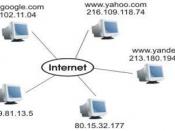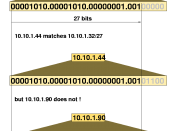Every computer on the internet has a unique address, called an IP address that distinguishes it from other computers on the internet. Currently, two version of IP addresses exist: IPv4 (Internet Protocol version 4) and IPv6 (Internet Protocol version 6). An IPv4 address has two parts that identify a specific computer: one part is to identify the network where that computer resides and a second part to pinpoint the specific computer or host within that network. An IPv6 address has three parts: a global prefix to identify the network, a subnet to identify the location within the network and the interface to ID to identify the specific computer or host. Today, IPv4 addresses are more commonly used. For this reason, the terms IP address and IPv4 are used interchangeably.
A typical IPv4 address - such as 72.14.207.99 - has four groups of numbers that range from 0 through 255. This form the IP address sometimes is called a dotted decimal number or dotted quad.
The four groups of numbers in the dotted quad are called octets, because they each have 8 bits when viewed in binary form for a total of 32 bits in the IP address. For instance, the binary form of 72.14.207.99 is 01001000.00001110.11001111.01100011.
Because each of the 8 bits can be 1 or 0, the total possible combinations per octet are 28, or 256. Combining the four octets of an IP address provides a possible 232 or 4,294,967,296 unique values. The actual number of available addresses is about 3 billions, because some values are reserved for special use and are off limits.
IP addresses, which are assigned by InterNIC ( The Internet's Network Information Center), belong to one of three network classes: A, B or C. In class A network, the first octet of the IPv4 address is...



Interesting
There are some nice facts here, quite interesting.
1 out of 1 people found this comment useful.